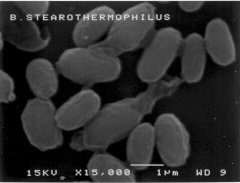Bacillus stearothermophilus NEUF2011
Geobacillus stearothermophilus
[8]Scanning electron microscope view
Classification:
Higher Order taxa:
- Kingdom: Bacteria
- Phylum: Firmicutes
- Class: Bacilli
- Order: Bacillales
- Family: Bacillaceae
Species:
- Geobacillus stearothermophilus.
Description and Significance:
Geobacillus stearothermophilus (or Bacillus stearophilus) is a rod-shaped, Gram-positive, spore forming bacterium. In addition, this bacterium is motile, strictly aerobic, and both catalase and oxidase positive. G. stearothermophilus grow in temperatures ranging from 30-75 degrees C, with an optimal growth temperature at 55°C. This thermophile can be found in warm eniromentments including: sand, ocean vents and hot springs. It has been observed to have to survived temperatures as high as 130 degrees C. Clinically, it is extremely significant because it is used to used to verify that laboratory sterilization processes are working properly. Both biological and chemical indicators are used to determine the presence of G. stearothermophilus' spores on surfaces that have undergone a sterilization process. [1]
G. stearothermophilus is also significant because of its role in food spoilage, mostly milk and dairy. During the pasturization process, dairy is often heated to temperatures that denature the molecules of pathogenic bacteria. However, G. stearothermophilus' unusually heat-tolerant enzymes and proteins allow it to survive this process. [5,6]
Genome Structure:
Geobacillus stearothermophilus has sixty-four genes that were successfully mapped in 1990 by Vallier and Welker of Northwestern University [2]. Their findings indicate that the genetic makeup of the G. stearothermophilus and the genetic makeup of a closely related species, Geobacillus subtilis, are very similar, with some important differences [2].
Cell Structure and Metabolism:
Since Geobacillus stearothermophilus is a Gram-positive bacteria, it has both an inner and outer membrane [3]. The cell surface of this microbe contains a capsule, a S-layer, several layers of peptidoglycan, and proteins on the outer membrane. The genus Geobacillus have S-layers, which are crystalline layers of surface proteins and like the S-layers of other bacteria, the role of these S-layers is unknown but thought to be connected to the adherence of the bacterial cell [3]. The capsules of Geobacillus stearothermophilus are easily observed using light microscopy especially if this bacteria is prepared on growth media that allows for heavy capsule production [3]. The cell wall contains a peptidoglycan that contains DAP or meso-diaminopimelic acid and this bacterial species has a substantial amount of teichoic acids bonded to muramic acid residues [3].
Ecology:
Geobacillus stearothermophilus is classified as a thermophile, and thus likes to live in temperatures ranging from 30-75 degrees C. It has been found in a variety of environments including: soil, hot springs, desert sand, Arctic waters, food, compost, and ocean sediment. It has tolerance to acid and its optimal temperature is 65 degrees C. Its enzymes and proteins are highly evolved to withstand extreme enviroments, including surviving 130 degree c temperatures. [3]
Pathology:
Currently, Geobacillus stearothermophilus have not been observed to be pathogenic to any host. Despite its widespread use as a popular method for verifying sterilization processes in the food industry, G. stearothermophilus have not been connected with any cases of food illness. [4]
Current Research:
A widely used enzyme in the dairy industry, β-Galactosidase, catalyzes the hydrolysis of β-galactosides into monosaccharides. This study reports the extracellular secretion of a cytoplasmic thermostable β-galactosidase from Geobacillus stearothermophilus IAM11001 in Bacillus subtilis. This would has potential applications in the dairy industry. [7]
Cool factor:
It has been observed to have to survived temperatures as high as 130 degrees C. Clinically, it is extremely significant because it is used to used to verify that laboratory sterilization processes are working properly. Both biological and chemical indicators are used to determine the presence of G. stearothermophilus' spores on surfaces that have undergone a sterilization process. [1]
References:
[1] NAZINA (T.N.), TOUROVA (T.P.), POLTARAUS (A.B.), NOVIKOVA (E.V.), GRIGORYAN (A.A.), IVANOVA (A.E.), LYSENKO (A.M.), PETRUNYAKA (V.V.), OSIPOV (G.A.), BELYAEV (S.S.) and IVANOV (M.V.): Taxonomic study of aerobic thermophilic bacilli: descriptions of Geobacillus subterraneus gen. nov., sp. nov. and Geobacillus uzenensis sp. nov. from petroleum reservoirs and transfer of Bacillus stearothermophilus, Bacillus thermocatenulatus, Bacillus thermoleovorans, Bacillus kaustophilus, Bacillus thermoglucosidasius and Bacillus thermodenitrificans to Geobacillus as the new combinations G. stearothermophilus, G. thermocatenulatus, G. thermoleovorans, G. kaustophilus, G. thermoglucosidasius and G. thermodenitrificans. Int. J. Syst. Evol. Microbiol. 2001, 51, 433-446.
[2] Vallier, H. & Welker, N. E. (1990). Genetic map of the Bacillus stearothermophilus NUB36 chromosome. J Bacteriol 172, 793–801.
[3] Todar, Kenneth. "Surface Structure of Bacillus." Textbook of Bacteriology. Madison, Wisconsin: , 2008. Web. 5 10, 2011.
[4] Hoshino, T. “Nucleotide sequence of the tetracycline resistence gene of pTHT15, a thermophilic Bacillus plasmid: comparison with stahphylocoocal TcR controls.” Gene 37, p. 131-138
[5] Inactivation of food poisoning bacteria and Geobacillus stearothermophilus spores by high pressure carbon dioxide treatmentSoichi Furukawaa, , , Taisuke Watanabea, Tetsuya Koyamaa, Junichi Hirataa, Naoki Narisawaa, Hirokazu Ogiharaa, Makari Yamasakib a Department of Food Science and Technology, College of Bioresource Sciences, Nihon University, Kameino 1866, Fujisawa, Kanagawa 252-8510, Japan b Advanced Research Institute for the Sciences and Humanities, Nihon University, 6F Ichigaya Tokyu Building, 4-2-1 Kudan-kita, Chiyoda-ku, Tokyo 102-0073, Japan
[6] Hwang, Andy; Huang, Lihan (2009-01-31). Ready-to-Eat Foods: Microbial Concerns and Control Measures. CRC Press. p. 88. ISBN 9781420068627. Retrieved 19 April 2011.
[7] Extracellular secretion in Bacillus subtilis of a cytoplasmic thermostable β-galactosidase from Geobacillus stearothermophilusY. Xia*, J. Zhao*, H. Chen*, X. Liu*, Y. Wang*, F. Tian*, H.P. Zhang†, H. Zhang*, W. Chen*, State Key Laboratory of Food Science and Technology, School of Food Science and Technology, Jiangnan University, Wuxi 214122, P. R. China Key Laboratory of Dairy Biotechnology and Engineering, Ministry of Education, Inner Mongolia Agricultural University, Huhhot, Inner Mongolia 010018, P. R. China
[8] SGM Biotech, A Division of Mesa Labs. Bozeman, Montana. 2010. (http://www.sgmbiotech.com/products/sem.php)

